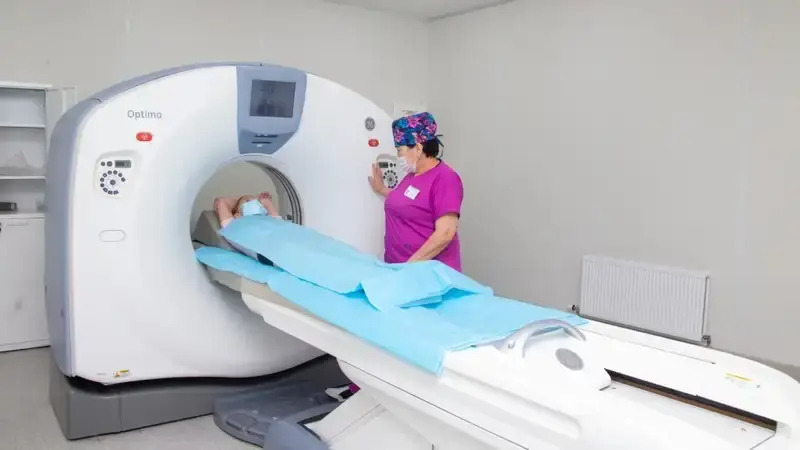ASTANA – Since gaining its regional status in May 2022, the Zhetisu Region has demonstrated an 18% economic growth rate. For the local authorities, the sustainability approach is becoming a guiding principle in modernizing industrial facilities and implementing greener solutions. Taldykorgan, the administrative center, is a central focus within the step-by-step transformation.

The center of Taldykorgan. Photo credit: egemen.kz. Click to see the map in full size. The map is designed by The Astana Times
Kazakhstan’s economic upturn is driving an increase in demand for electrical and thermal energy. This shift is not only reshaping the energy landscape but also driving changes in industrialization, particularly in the southern city of Taldykorgan.
Taldykorgan’s gasification
Two months ago, in February, the Taldykorgan akimat (city administration) announced the implementation of a green three-phase project for 2024-2025. Private investments of 37 billion tenge (US $83 million) will be allocated for the construction of a gas turbine power station with an installed capacity of 100 gigacalories of thermal energy and 80 megawatts of electrical energy.

Baskuat, a major boiler plant in Taldykorgan, is undergoing modernization. It was established in 1981. Photo credit: primeminister.kz.
Baskuat Energo proposed the idea. Arman Otarbayev, the company’s director, assured that the first phase of the project will be completed between May and October.
The investments will enhance the capacity of the existing heating system at the Baskuat boiler plant, which supplies Taldykorgan with 65% of its thermal energy. The city has 10 boiler plants overall.
Baskuat provides heating to more than 500 apartment buildings, 1,000 private residences, 20 schools, 25 preschools, 10 hospitals, and 90 administrative buildings. The data was provided by the Prime Minister’s press service following the working visit of the then head of the government, Alikhan Smailov, to Taldykorgan last year.
During the inspection of the infrastructure and industrial facilities of the Zhetisu Region, Smailov tasked the local authorities to step up activities for the transition of the boiler plant to gas.
This step, he noted, will “enhance its efficiency and make a significant contribution to addressing environmental issues.”
According to the Kazakh Ministry of Energy, the gasification rate of the region totals 41.2%.
Sustainable energy solutions can’t go without renewables. The latest update from the Zhetisu Region akimat indicated that there are 11 renewable energy facilities with a total capacity of nearly 160 megawatts in the region.
The state of Taldykorgan industrial zone
Facilitating investor engagement and fostering public-private partnerships stand as paramount directives set forth by the head of state. The establishment of industrial zones emerges as an avenue for realizing these objectives.
Given a visible decline in investment inflow, the Taldykorgan industrial zone, which includes only six industrial enterprises, requires special attention.

Taldykorgan city entrance. Photo credit: arnapress.kz.
There are a raft of challenges for its further development, such as unused land, frequent power outages, and problems related to public transportation routes.
In this regard, the akimat has instructed to intensify efforts in attracting enterprises and investors to provide support to entrepreneurs within the national entrepreneurship development project for 2021-2025 and the business roadmap for 2025.
The plans include opening enterprises for manufacturing construction materials, rechargeable batteries, and constructing a grain storage facility.
By 2025, the Zhetisu Region strives to have a pool of 316 investment projects totaling 1.8 trillion tenge (US$4 billion) and to create 14,000 jobs.
Today, 26,000 workers of 535 industrial enterprises in the region produce sugar, malt, electric batteries, concrete and metal poles for high-voltage power lines, among other products.
In 2022 alone, the region introduced 17 new facilities and manufactured industrial goods worth over 280 billion tenge (US$626 million).
People are the primary focus
Yet another breakthrough for the region is the commission of 59 new medical facilities. This year, it is planned to construct 15 medical outpatient clinics, 39 paramedic and midwifery points, and five medical posts across eight districts.
In addition, existing buildings will undergo capital repairs as part of the modernization of rural health care. For these purposes, the government allocated 1.277 billion tenge.

In 2024, it is planned to install an angiographic system and a modern magnetic resonance imaging (MRI) machine. Photo credit: zakon.kz.
According to the regional health department, total healthcare funding amounted to 90 billion tenge (US$201 million) in the past year.
These initiatives were proposed as part of the national project to modernize rural healthcare. In the next three years, an additional 118 primary healthcare facilities are expected to be opened.

The Active Longevity Center in Taldykorgan. Photo credit: Kazinform news agency.
Those committed to a medical career in the region will receive incentives ranging from three million tenge (US$6,700) to 8.5 million tenge (US$19,000). As a result, 86 young doctors were appointed for the work at the beginning of 2024.
In January this year, Taldykorgan introduced the Active Longevity Center. Its primary objective is the socialization of individuals of retirement age, aiming to engage them actively in cultural, creative, sports, and business spheres of life.
“We offer courses on financial literacy, computer skills, English and Kazakh languages, knitting and sewing. Additionally, we have a gym, yoga classes, vocal training, chess and checkers, as well as table tennis,” said Asset Orazbekuly, the head of the center.
The list of its regular visitors includes 210 elderly people.
Another focus for the Kazakh authorities in the region is centered around comfortable living conditions for the citizens.
Last October, Kazakh President Kassym-Jomart Tokayev visited a newly developing residential area in the region and inspected the progress of construction projects within its territory. The area includes 41 residential buildings with 1,510 apartments spanning 122,600 square meters.

President Tokayev during his visit to the Zhetisu Region in October 2023. Photo credit: ortcom.kz.
In the short term, 28,000 individuals, representing 14% of the city’s population, will become residents of the newly developed residential areas.
The administrative-territorial changes, including the creation of the Zhetisu Region alongside other regions, were introduced by Tokayev in May 2022 to “optimize public administration, simplify commuting to and from the regional center, and better regulate internal migration.”


